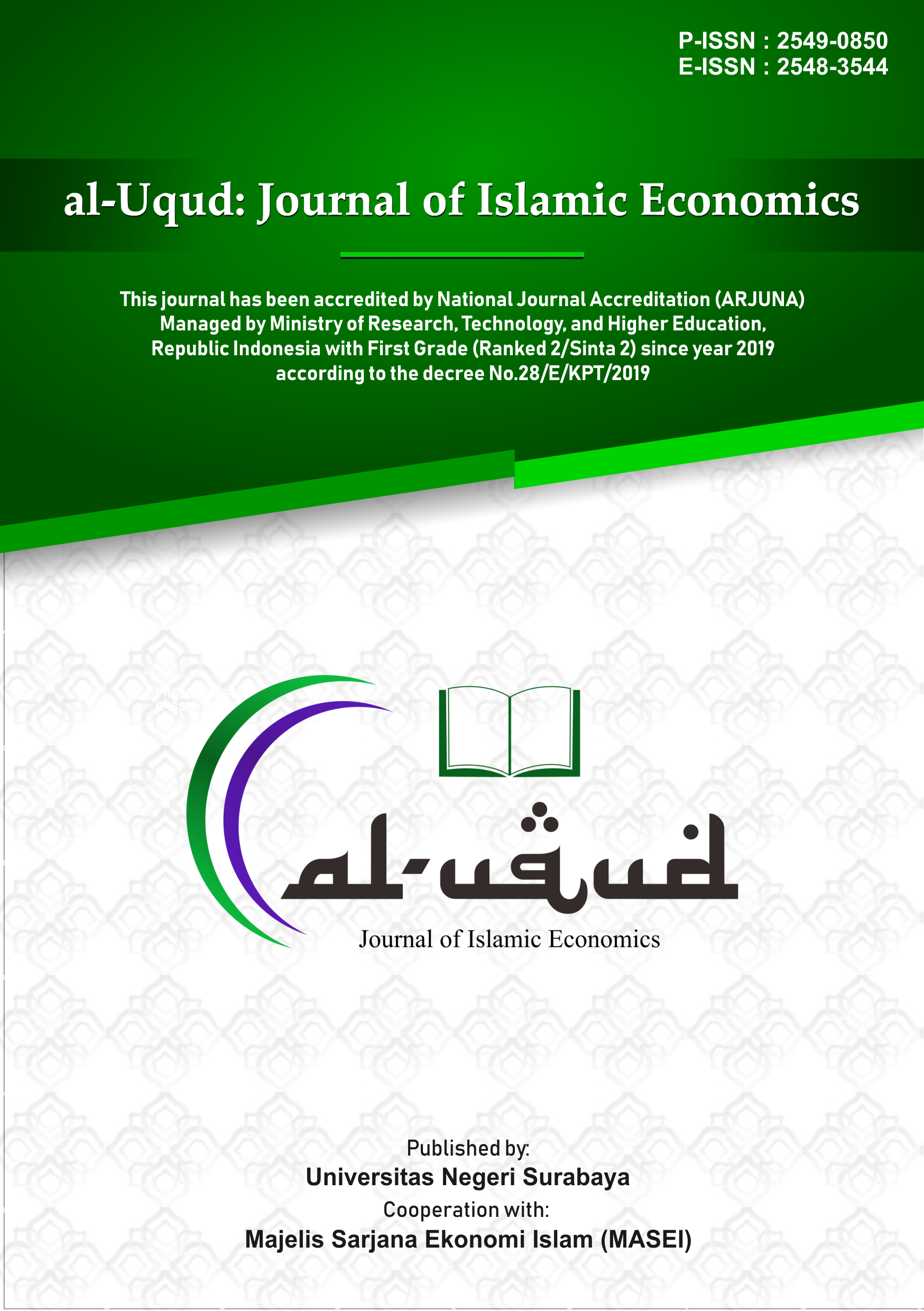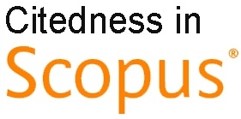Solution for Islamic Banks Exploitation: A Criticism of Fixed-Yields Based Financing in Indonesia
DOI:
https://doi.org/10.26740/al-uqud.v4n1.p48-68Keywords:
Exploitation, Financing, Fixed yields, Predatory, Profit sharing.Abstract
The profit-sharing system is the main characteristic of Islamic banking that distinguishes them from conventional (ribawi) banking. However, in reality, the profit-sharing contract is rarely implemented in Islamic banking. As a result, Islamic banking is still identified as ribawi banking. Many Islamic economists have examined the reasons behind fixed income contracts, especially murabahah contract that applied predominantly, structurally, systematically and massively compared to the profit-sharing contract. Therefore, with a critical analytical approach, this study aims to dismantle and look for solution towards exploitation of fixed income-based financing in Indonesian sharia banking. The results of this study are fixed income-based financing should be applied limited to covering the operational costs of Islamic banks but the remainder must be channelled based on profit-sharing systems. Meanwhile, funding for profit-sharing systems is intended to gain profits and cover the operational cost variables. Thus, predatory exploitation of Islamic banks in Indonesia can be minimized by maintaining the composition of the maximum financing about forty per cent which is a fixed-yield based and leave the rest to a profit-sharing system. Then, the more equitable Islamic bank system and Islamic economic goals will be created and offer benefits such as the achieving of the objectives of Islamic sharia (maqashid shariah) and minimizing the image of Islamic banks as ribawi bank.
References
Al Ghazali, A. H. (1983). Al- Mustashfa fiilm al Ushul. al-Kutub al- Ilmiya.
Allain, J. (2012). Slavery in International Law: Of Human Exploitation and Traffic. Martinus Nijhoff Publishers. https://doi.org/10.1163/9789004235731
Ascarya. (2010). The lack of profit and loss sharing financing in Indonesias Islamic banks: Revisited. Review of Indonesian Economic and Business Studies, 1(1), 5780. http://www.iefpedia.com/english/wp-content/uploads/2009/09/THE-LACK-OF-PROFIT-AND-LOSS-SHARING-FINANCING-IN.pdf
Bacha, O. . (1995). Conventional versus Mudarabah Financing: An Agency Cost Perspective. IIUM Journal of Economics and Management, 4(2), 3350. https://journals.iium.edu.my/enmjournal/index.php/enmj/article/view/27
Bebczuk, R. N. (2003). Asymmetric information in financial markets: Introduction and applications. Cambridge University Press. https://doi.org/10.1016/j.bar.2003.10.005
Dar, H. and Presley, J. R. (2000). Lack of Profit Loss Sharing in Islamic Banking¯: Management and Control Imbalances. International Journal of Islamic Financial Services. https://ekisopini.blogspot.com/2009/09/jual-international-journal-of-islamic.html
Farooq, M. O., Farooq, M. O., & Ahmed, A. (2015). Article information¯:
Febianto, I., & Kasri, R. A. (2012). Why Do Islamic Banks Tend to Avoid Profit and Loss Sharing Arrangements? SSRN Electronic Journal. https://doi.org/10.2139/ssrn.1672127
Fiafifah, A. L., & Darwanto, D. (2019). Technical Efficiency Level of Islamic Bank in Indonesia. Al-Uqud¯: Journal of Islamic Economics, 3(2), 114. https://doi.org/10.26740/al-uqud.v3n2.p114-132
Geisst, C., Goette, L. and Meier, S. (2010). Collateral Damaged: The Marketing of Consumer Debt to America. Bloomberg Press. https://doi.org/10.5860/choice.47-2113
Hanif, M. (2016). Economic substance or legal form: an evaluation of Islamic finance practice. International Journal of Islamic and Middle Eastern Finance and Management, 9(2), 277295. https://doi.org/10.1108/IMEFM-07-2014-0078
Hendratmi, A., Ryandono, M. N. H., & Sukmaningrum, P. S. (2019). Developing Islamic crowdfunding website platform for startup companies in Indonesia. Journal of Islamic Marketing. https://doi.org/10.1108/JIMA-02-2019-0022
Henry, C., Wilson, R., & Yousef, T. M. (2012). The Murabaha Syndrome in Islamic Finance: Laws, Institutions and Politics. In The Politics of Islamic Finance. https://doi.org/10.3366/edinburgh/9780748618361.003.0003
Herianingrum, Sri, et all. (2017). The Impact of Islamic Bank Financing on Business. Entrepreneurship and Sustainability Issues, 4(4), 133145. https://doi.org/10.9770/jesi.2019.7.1(11)
Kusuma, K. A. (2016). Zakah index¯: Islamic economics welfare measurement. Indonesian Journal of Islam and Muslim Societies, 6(2), 273301. https://doi.org/10.18326/ijims.v6i2.273-301
Kusuma, K. A., Santosa, N. E. T. I., Mursinto, D., & Ryandono, M. N. H. (2018). Profit-sharing ratio determination of Mudharabah contract in Indonesia islamic banks. Opcion. https://www.researchgate.net/publication/331271239_Profit_Sharing_Ratio_Determination_of_Mudharabah_Contract_in_Indonesia_Islamic_Banks
Lewis, M. K. & L. M. A. (2007). Perbankan Syariah: Prinsip, Praktek dan Prospek (T. oleh B. Subrata (ed.)). PT Serambi Ilmu.
Majeed, M. T., & Zainab, A. (2018). Shariah practice at Islamic banks in Pakistan. Journal of Islamic Accounting and Business Research, 9(3), 274289. https://doi.org/10.1108/jiabr-03-2015-0011
Mannan, M. . (1970). Islamic Economics, Theory and Practice. The Islamic Foundation.
Ryandono, M. N. H. (2009). Bursa Efek dan Investasi Syariah. Serambi.
Ryandono, M. N. H. (2018a). Sukuk model determinant as funding strategy of Islamic Bank in Indonesia. Ijtihad¯: Jurnal Wacana Hukum Islam Dan Kemanusiaan, 18(2), 153. https://doi.org/10.18326/ijtihad.v18i2.153-174
Ryandono, M. N. H. (2018b). WAQF and Sukuk as economic financing sources in infrastructure development in Indonesia. Opcion, 34(86), 16991713.
Saeed, A. (1998). Idealism and pragmatism in Islamic banking: The application of shariah principles and adjustments. Journal of Arabic, Islamic and Middle Eastern Studies, 4(2), 89111.
Samad, A., Gardner, N. D. and Cook, B. J. (2005). Islamic banking and finance in theory and practice: The experience of Malaysia and Bahrain. The American Journal of Islamic Social Science, 22(2), 6986.
Syahdeini, S. R. (1999). Perbankan Islam dan Kedudukannya dalam Tata Hukum Perbankan Indonesia. Grafiti.
Usmani, M. T. (2002). An Introduction to Islamic Finance. The Hague, Kluwer Law International. In An Introduction to Islamic Finance. The Hague, Kluwer Law International.
Wilson, R. (2011). (n.d.). The Determinants of Islamic Financial Development and The Constraints on its Growth. 4th IFSB Lecture on Financial Policy and Stability.
Zubair, M., & Choudhry, G. (2014). Islamic Banking in Pakistan: A Critical Review. International Journal of Humanities and Social Science, 4(2), 116.
http://www.ijhssnet.com/view.php?u=http://www.ijhssnet.com/journals/Vol_4_No_2_Special_Issue_January_2014/16.pdf
Downloads
Published
How to Cite
Issue
Section
License
CC BY 4.0 Abstract views: 1040
,
Abstract views: 1040
, PDF Downloads: 539
PDF Downloads: 539








